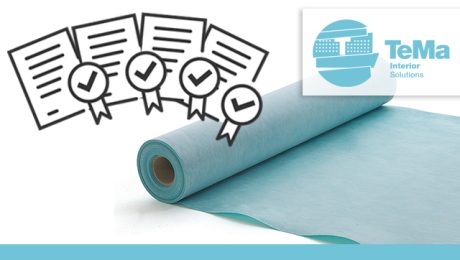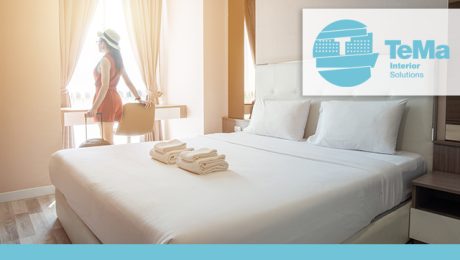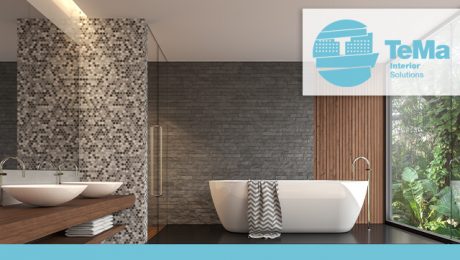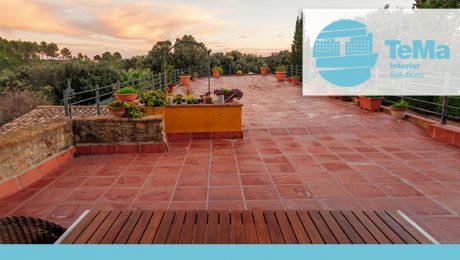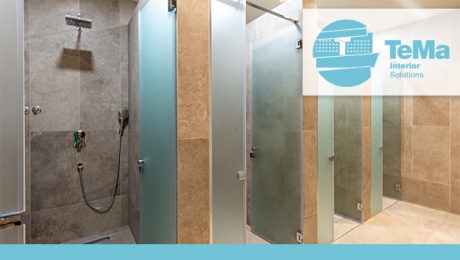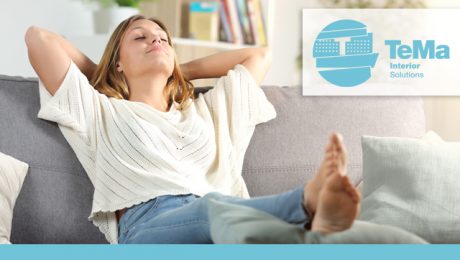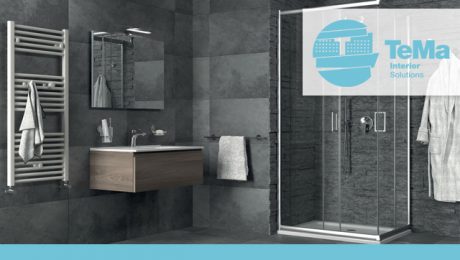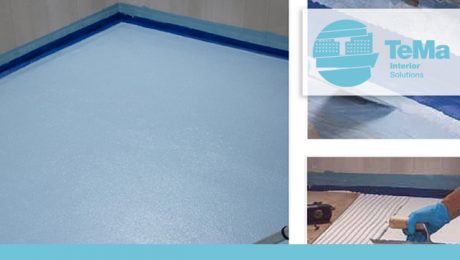TH2 Stop: certified waterproofing
As mentioned many times before, the problem of moisture and water vapour on walls and floors, both indoors and outdoors, is not to be underestimated. TH2 Stop from TeMa Interior Solutions, consisting of three layers, is the waterproofing membrane that fulfils its waterproofing function by blocking any damage caused by moisture before it forms.
Once the membrane has been applied, any surface can be laid over it: tiles, stone, cement resin, marble or plaster. It’s the ideal solution for insulating the bathroom from moisture and water vapour, keeping the surfaces healthy for a long time: as long as the life of the home. In renovations and in new buildings, installers prefer TH2 Stop for its safety and user-friendliness.
TH2 Stop is guaranteed to provide top performance and has been certified in Europe and beyond. US certification was obtained by passing the tests required by various standards:
- The ANSI A118.10 (American National Standard Specifications) regulation sets out the standard requirements for load-bearing, bonded, waterproof membranes for laying ceramic and natural stone tiles.
- The ASTM E96 standard for assessing membrane water vapour transmission, in accordance with the Annex.
- The ASTM C627 standard for passing the Robinson Wheel Test, with the highest Heavy Commercial rating.
At the European level, TH2 Stop has also obtained CE certification through ETA (European Technical Assessment) in compliance with ETAG 022 Class A and C (waterproofing bonded with ceramic tiles). The directive concerns watertight covering kits for floors and/or walls of indoor wet rooms.
TH2 Stop and its accessories can be used to seal joint areas between panels or adjacent sheets and all critical points, thereby creating a fully waterproof system.
For innovative products or products not yet covered by a standard, an alternative to harmonised EN standards is the issuing of a European Technical Assessment (ETA). This document consists of the approval of the suitability for use of a certain product, consistent with ETAG guidelines. ETAG guidelines are prepared under an EC mandate by a special European organisation EOTA (European Organisation for Technical Assessment) comprising national administrations and institutes responsible for assessing the technical suitability of innovative products.
TH2 Stop also passed the tests required by the European AbP (Allgemeines Bauaufsichtliches Prufzeugnis) standard, the most stringent in the industry. This building inspection certificate issued by accredited German building authorities in the sector allows the product to be distributed in the German market.
- Published in Baths and showers rooms, INTERIOR, Levelling, or structural, waterproofing panels, Waterproofing system with membranes
Hotels and acoustic comfort
Acoustic well-being is also included in the concept of comfort in hotels.
Vibrations and sound waves disturb guests and there can be many sources of origin: panoramic pools with adjacent rooftop bars, air conditioners, bathroom drains, laundries, lifts, but above all corridors and areas where people with upright suitcases are constantly passing through.
In Italy, for example, speaking of acoustic comfort and governing its implementation is Prime Ministerial Decree of 5/12/97, which establishes the limit values, calculation methods and requirements to be achieved in order to reduce exposure to excessive noise.
How can I soundproof high-frequency spaces from footfall noise?
Carpets and vinyl flooring or similar materials can add to the insulating effect, but the ‘bulk’ of the work is done by acoustic insulation systems.
Depending on the need to reduce decibels and the available time frame, under-screed or under-tile application can be chosen.
In the first case, the floating screed technique allows structural elements to be separated, preventing the transmission of vibrations. In the second case, instead, dry systems, ideal for less invasive and cost-conscious renovations, that do not require new screeds, allow you to reduce intervention times and install sound insulation directly under the floor. In exceptional cases, they can also be installed over an existing floor by re-laying tiles or other chosen surfaces.
The approach of TeMa Interior Solutions
T-Silence offers excellent acoustic insulation performance and can be applied under any finish, including wood, PVC, ceramic tiles and stone.
For under-tile applications, our range includes T-Silence dB21, the panel consisting of a polymeric inner core bonded on both sides with special fabrics, and T-Silence dB17, the roll consisting of a polymeric sheet bonded on one side to a resilient polypropylene non-woven fabric, and on the other side to a spunbonded fabric.

For under-screed applications, instead, we recommend:
- T-Silence 3.8 mm, the honeycomb membrane bonded with a waterproof membrane.
- T-Silence 5 mm, the closed-cell, cross-linked polyethylene foam insulation.
- T-Silence 9.5 mm, the three-dimensional monofilament mat bonded to a breathable waterproof membrane, with butyl selvedge edge for overlapping.
- T-Silence 10 mm, in closed-cell, cross-linked polyethylene foam.
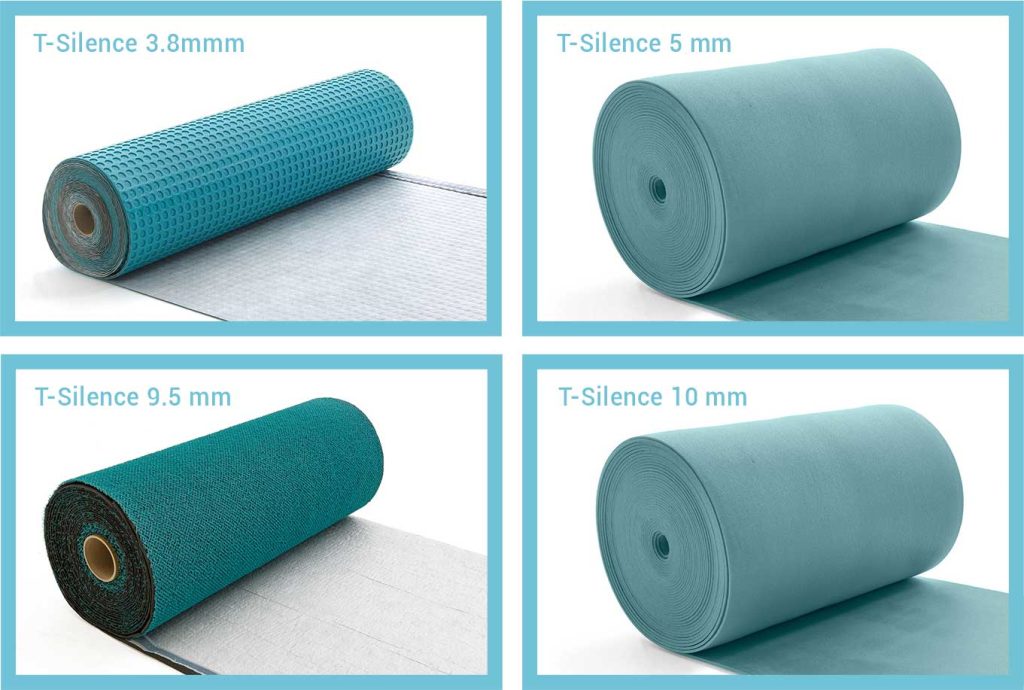
The range is complemented with accessories such as tapes and adhesives for sealing joints.
Furnishings and accessories for designer bathrooms
Large or small, square or rectangular, with or without a panoramic view, the bathroom is always an intimate place that needs to combine functionality with relaxation. It’s a room that’s used very often, which is why everyone tries to make it a pleasant experience and personalise it according to their own taste.
A new soap dish, a rug to contrast with the floor and a larger mirror are good starting points, but it’s strictly in architectural terms that spaces can be customised.
Let’s see how.
SOLUTIONS FOR NEW CONSTRUCTION
The first thing to bear in mind is the fact that the bathroom is a place with a high amount of humidity and vapour, therefore any intervention works must provide suitable long-lasting solutions.
The TeMa Interior system allows many intervention works to make your bathroom extremely personal, including creating walls, making the spaces you want and external cladding for the bathtub with a whirlpool and shower, or creating structures for washbasins, shelves, niches or small cabinets.
Water Panel gives you the opportunity to create self-supporting partition walls for a sophisticated look in the bathroom. Its wide range of thicknesses (see data sheet) makes it an extremely adaptable and functional product.
It can be used as cladding for the bathtub and shower, also because it’s waterproof and prevents the risk of water seepage, which would cause costly damage, and conceals fixtures, therefore becoming a true furnishing element. In addition, since it’s cut to size, it offers the very advantageous option of making the shower or bathtub the required size.
Also for washbasins and walls for the installation of sanitary fixtures, creative solutions can be found with Water Panel: the structure supporting them, whether just one or many more, can be custom-made with a mirror recess and shelves.
Of course, Water Panel can be cladded with your choice of finish: tiles or plaster.
To make it even more visually attractive, you can choose to include niches thereby maximising the use of space. T-Niche is the ideal waterproofed prefabricated product for all your needs.
The above-mentioned products are very light, extremely easy to handle and can also be carried to upper floors without requiring a freight lift.
RENOVATION SOLUTIONS
Workers in the house, bathrooms out of use and dust everywhere: the nightmare can be minimised if you choose to waterproof your shower with TH2 Stop, the membrane that can be applied under tiles with standard cement glue and cladded as desired.
Accessories
To complete the work at critical points, such as corners, specific products can be used such as T-Corner I and T-Corner E, whereas at panel joints, where there are fixtures and drains, T-Bandel can be applied and fixed with T-Fix.
What are the advantages?
All solutions can be customised to the millimetre, on-site and without causing any dust, for quick installation. This allows unprecedented speed of work with the highest performance ever.
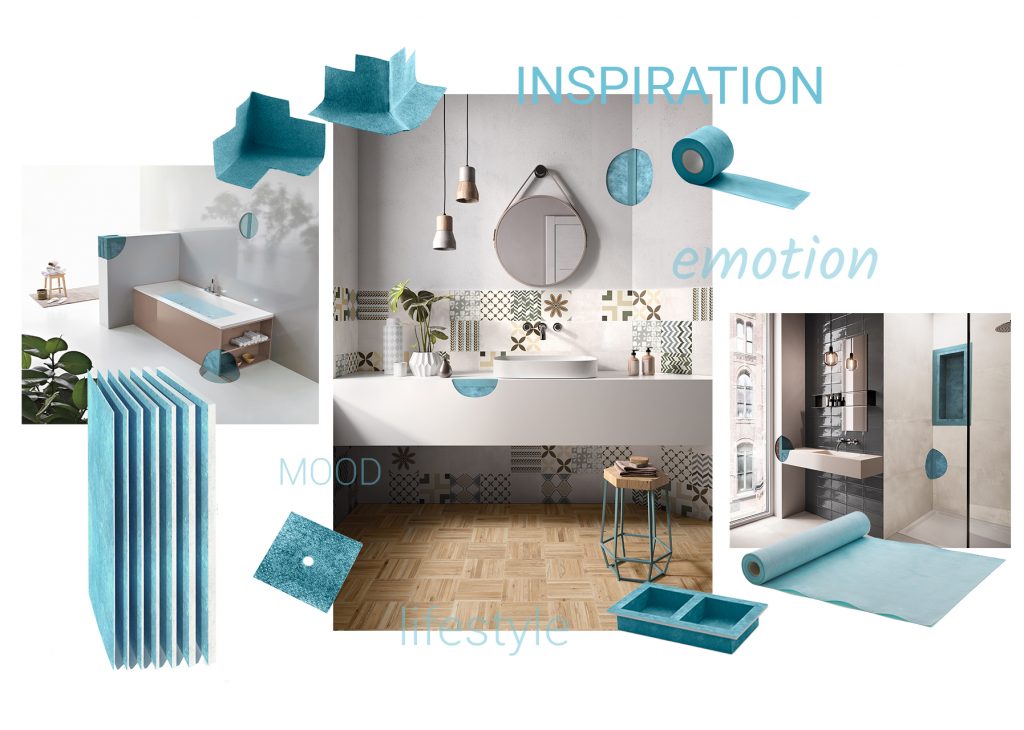
- Published in Baths and showers rooms, INTERIOR
Protecting outdoor flooring with drainage geocomposites
Autumn precipitation, winter frosts and scorching summer heat may even be followed by a downpour lasting a few minutes. Terraces and balconies, or outdoor flooring in general, are affected by seasonal and sometimes daily weather events and temperature fluctuations that put the resistance of flooring at risk.
So how can we protect them?
Drainage geocomposites are the solution, but let’s take a closer look at them and their functions.
What are drainage geocomposites and when should they be used?
They are geosynthetic materials with a drainage core bonded to a non-woven filtering fabric. They can be used on walls, underground structures, flat roofs, trafficable roofs, flat green roofs, as well as terraces, balconies and outdoor flooring.
TeMa Interior Solutions suggestsT-K NW and T-K Net, polyethylene studded membranes bonded to a non-woven fabric that acts as a filtering layer for T-K NW or a HDPE mesh for T-K Net.
What are the functions?
The functions of geosynthetic products are set out in the UNI EN ISO 10318 standard.
![]()
Drainage
As the name implies, the main function of geosynthetic products is to drain any water that may seep into the screed. Passive capillary drainage eliminates the risk of stagnant water in the system and, if there are rooms below, prevents moisture from damaging the insulating layer.
![]()
Protecting the waterproofing layer
Damage to the waterproofing layer causes significant and immediately visible problems. Moisture and water penetrating into deeper layers, compromise the durability and strength of the structure, causing cracks in tiles. Protection is therefore necessary.
![]()
Distributing the load
Flooring often has to withstand heavy loads, such as outdoor tables, sunshades, large plant pots etc…. Using studded membranes, which are highly resistant to loads, allows the screed to remain “suspended” from the sealing layer (i.e. the waterproofing layer) below, protecting it from perforations and abrasions.
Advantages of applying the system
The time required is extremely short and flooring can be laid after a few days.
The thickness of the membranes is much reduced, an advantage not to be underestimated in renovations. Moreover, the thresholds of French windows opening outwards or onto a terrace do not need to be raised.
Lastly, in consideration of the environment, the materials are safe and odourless. They do not develop toxic gases or organic components, and comply with VOC standards. No hazardous substances are released underground.
The solution to humidity in swimming pool shower rooms
Don’t smile at the obvious: a swimming pool is one of the most humid environments you can find, especially the changing rooms, where there are shower rooms and often inadequate aeration.
Vapour, water drops on the walls and permanently wet floors are the problems we find, but the unknown arises when humidity also penetrates the walls. And that’s when invisible damage starts to affect the structure.
Clearly, the most obvious consequence of humidity is the appearance of stains and moulds which, as we all know, are not healthy for people or for the structure, but fortunately they are a clear sign that something is wrong.
When swimming pools are open to the public, and therefore very busy, all designers know that it’s important to prevent any signs of deterioration in the toilet and shower area. Basically, this is the area where user’s sensitivities are aroused, and so it’s important to look for the most suitable materials and finishes, using hardwearing elements capable of resisting over time. In addition, the products used must be completely waterproof and resistant to humid environments.
If not properly considered right from the design stage, there’s a real risk of encountering problems with damp, tiles coming off and walls that flake off very quickly.
Moreover, the problem is worsened by the temperature difference between inside and outside during the coldest periods.
The solution from TeMa Interior Solutions
We are specialised in damp-proofing and waterproofing at large construction sites, and now also in interior solutions. We have therefore developed the right product to be vapour- and water-resistant. For example, Water Panel, the XPS (extruded expanded polystyrene) panel bonded with waterproof facers on both sides, to which cement-based glue can be directly applied for laying tiles or other claddings that design now has to offer.
The advantage of this product is that it’s ready to use, i.e. quick and easy to assemble while ensuring maximum performance and customisation. Being lightweight is a huge advantage on-site, as well as the fact that it can be cut without creating dust. In addition, it’s ideal for a variety of applications, as it’s available in a wide range of thicknesses from 6 mm to 50 mm.
Available accessories include:
- an adhesive for fixing;
- T-Corner I/E for waterproofing corners;
- T-Bandel for joining panels;
- T-Fix for applying to gaps between panels;
- T-Wall Collar for waterproofing the outlet areas of installations.
- Published in Baths and showers rooms, INTERIOR, Waterproofing with panels
Dry Renovation: a Quick and Clean Method
At an historic moment in time when everything is coming to a halt, we must not forget that we still have ways to increase our knowledge and get ready for the time when everything gets back to normal. The home, for obvious reasons, is now the focus of our thoughts. The more days go by, the more we notice some jobs that have been left aside for too long: a basement to be fixed, a wall to be better insulated or a terrace floor to be changed because it is excessively damaged. So let’s discover something more about one of the ways to renovate those parts of the home that require our attention.
Dry renovation: a valid solution
The dry renovation system is a processing method that does not involve the use of water, adhesives or sealants that need to remain in place to dry. Although Italy has always opted for the so-called wet clay-cement system, this does not mean that new methods have not recently been explored. This traditional work method was cast aside during the years of crisis in Italy in the building industry, since it focused on protecting the existing heritage and, therefore, on renovating rather than building from scratch.
Renovating, synonymous with saving
After all, renovating becomes synonymous with energy efficiency. You save on your bills and gain in terms of wellbeing and living comfort, primarily by enhancing the value of your property. The dry installation system, which can be applied to the outside of a building, to its structure or to its internal system, offers many advantages.

We talk about the eco-sustainability of new materials, because they can be recycled, replaced if damage or deterioration occurs, and even re-used. Moreover, dry renovation allows much quicker intervention times and more sustainable situations because tenants do not need to leave their homes during intervention works.
The materials and method used by TeMa
In the specific context of TeMa Interior, the division dedicated to floors, balconies and terraces, soundproofing and waterproofing membranes are used that are easily shaped and transported because of their minimal weight.

Combined with dry installation, these materials allow short intervention times and greatly reduced costs. But remember that this does not entail any reduction in the performance of the intervention work. The final cost of any intervention will be lower because the thickness of the membranes is reduced and, consequently, the quantity of the materials used.
It is precisely the materials, with their physical properties and excellent performance, that ensure the efficiency of intervention work, first and foremost by facilitating the procedures involved.
To find out about all our applications, visit our website.
A new wellbeing range
As humans, one of our basic needs is to create a nest that is warm and dry, and protected from bad weather conditions, hoping that a woodpecker will not come along and live above this nest. Unfortunately, we do not always realise that what affects people’s wellbeing is not only the pleasure of the warmth that an isolated environment brings, but also the silence.
Silence has only recently been re-evaluated as a category
Silence has only recently been re-evaluated as a category of wellbeing. Modern culture has allowed it to be acknowledged as a pre-requisite for a peaceful life. The concept of health has extended its boundaries to include other areas such as noise, which, together with other factors such as light and temperature, influences people’s good living. The World Health Organization (WHO) defines the concept of health as “a state of complete physical, mental and social wellbeing and not merely the absence of disease or infirmity.” Enjoying good sound insulation in the home is therefore not an extra but a necessity. This is why TeMa Interior decided to create T-Silence to reduce footfall noise.

T-Silence, a universally valid option
To make T-Silence a universally valid option, Tema decided to use materials with narrow thicknesses, minimally invasive intervention methods and reduced on-site installation times. In this way, those who are building from scratch or renovating and those who already live in a building and cannot leave it temporarily can make use of the system. Dry applications are used that do not require new screeds and therefore a drying cycle is not necessary. A further advantage not to be overlooked is the option of applying T-Silence without demolishing the existing floor and/or the screed below. This avoids any inconvenience for tenants and ensures quick installation.

So, what is the advantage of soundproofing your home? You can achieve your own wellbeing.
Silence will accompany your daily routine, aiding concentration and avoiding any change in your mindset that normally leads to anxiety, depression and discontent. In the evenings, you will have no problem falling asleep, you will not be woken up in the middle of the night by noisy neighbours and you will allow your brain to re-work the stimuli collected during the day and peacefully fix your memories. Sleep considerably affects everyone’s ability to concentrate and promotes growth processes, which is why it should not be underestimated.
This is why a system like T-Silence becomes essential: because it preserves, protects and enhances your wellbeing. Spread the word and tell the neighbours above you and think about those below you.
If you want to learn more and discover the T-Silence application methods, browse the CATALOGUE.
TeMa waterproofing systems
Three-layer waterproofing membrane for sub-tile applications for the protection of walls and floors from steam transmission with accessories
Discover the theme solutions to make your bathroom safe and dry, watch the video
Baths and showers: TeMa waterproofing systems
Discover the three-layer waterproofing membrane for sub-tile applications for the protection of walls and floors from the transmission of steam with accessories
Discover the theme solutions to make your bathroom safe and dry, watch the video

